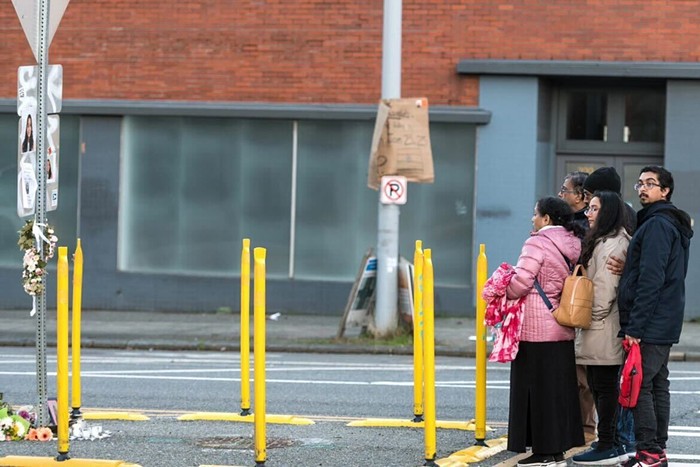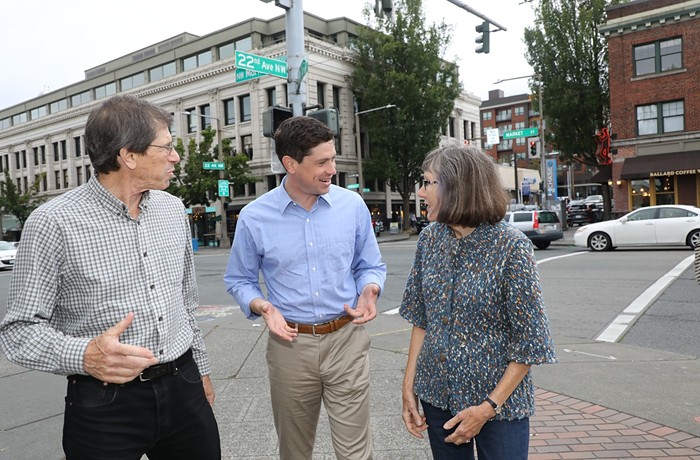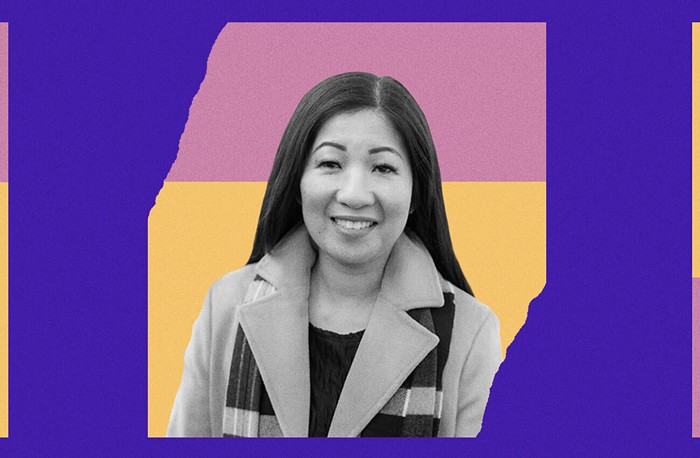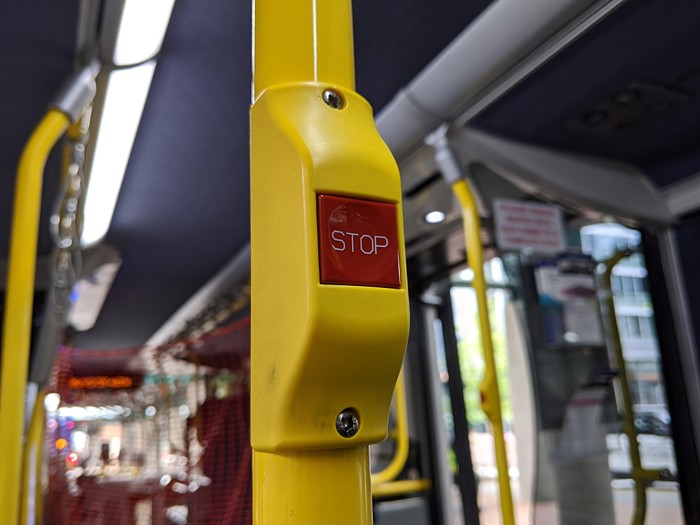Or is it? Could the time be right for a Regrade Renaissance? Could the neighborhood again be destination, hangout, and home for hipsters, musicians, artists, and other boho types?
Steve Freeborn, Tia Matthies, and Jerry Everard hope so. They've taken over the Rendezvous Lounge and Jewel Box Theater, which opened in 1926 as a watering hole and screening room for local movie-distribution representatives and theater managers, more recently one of the area's last and rowdiest working-stiff bars. Freeborn and Matthies ran the OK Hotel before that legendary Pioneer Square club was shuttered by last year's Ash Wednesday earthquake. Everard was a partner in Moe, the 1994-97 Capitol Hill rock club, and still owns a piece of its former building, which now houses the Arena dance space.
"We want to be more of a neighborhood place where people can be comfortable on a regular basis," Everard explains. Matthies adds, "I don't want it to be so funky that the people in the condos don't want to go there; but I don't want it to be so upscale I wouldn't want to go there."
While most of the affordable housing units in Belltown disappeared during the boom years, the area nevertheless remained a hangout for hipsters and artists. Places like the Lava Lounge and the Two Bells Tavern continued to attract current, former, and never-were Belltown residents all through the boom years. These types of places and the return of the Rendezvous may be a partial foundation for the return of the old Belltown funk.
That might be little more than a fanciful dream at this moment. But Belltown has always attracted dreamers.
A BRIEF HISTORY OF BELLTOWN
In the early 1850s, local pioneer William Bell took out a land claim at the western foot of Denny Hill, over a mile north of the main white settlement in today's Pioneer Square. Decades later, city engineer R. H. Thomson dreamed of a flat, easy-to-develop new neighborhood in Denny Hill's place. Between 1905 and 1930, over 50 blocks were lowered by as much as 100 feet, creating the Denny Regrade (now used interchangeably with the name "Belltown"). Civic planner Virgil Bogue dreamed of a grand civic center in the newly cleared space, and in 1911 drew up a vast plan for tree-lined boulevards and Beaux Arts buildings. Voters turned his plan down by nearly two to one. Instead, the Regrade/Belltown area became home to labor-union halls, printing plants, movie-distribution offices, car lots, modest apartments, and sailors' taverns; by the 1960s it was also home to the monorail line and a few movie theaters.
Artsy types started showing up in the late '70s, attracted by the low rents and proximity to downtown. At the time, the 3,000 housing units in greater downtown (including Belltown) were mainly occupied by old-age pensioners, lower-middle-class singles, down-and-outers, hookers, and drug dealers and users. The boho crowd coexisted with the old-timers at places like the Frontier Room and the Virginia Inn. The art-worlders also established their own hangouts: the Virginia Inn, the Two Bells, Cyclops and Belltown cafés, the gay disco Tugs, the new-wave club Wrex (later the original Vogue, now the Vain hair salon).
At this same time, the city rezoned most of Belltown to allow high-rise offices and condos (it was one of the few big areas of Seattle not restrictively zoned for single-family homes). Over the next decade and a half, housing construction came in fits and spurts with the local economy's boom-and-bust cycles. Then in the '90s, with the software boom and increasing interest in urban living, construction of condos and "luxury apartment homes" exploded. By 1998, it seemed every low-rise building in Belltown was either being torn down for high-rises or being turned into offices for the architects who designed the high-rises. As the old-timers died off or got kicked out, many of the area's former downscale hangouts were closed (the Frontier Room) or altered (the Queen City Grill) to the point where the remaining old-timers no longer felt welcome. Developers traded on the neighborhood's "artistic" reputation, but continued to destroy artists' spaces (most infamously the SCUD co-op building, home of the original Cyclops and the 66 Bell studios) for new condos.
A few of Belltown's new (Security House, Ellis Court) or renovated (the Bremer, the Fleming) apartment buildings were run by nonprofits like the Plymouth Housing Group and the Capitol Hill Housing Improvement Program, and this allowed some of the old-timers to stick around. The Cornelius apartments at Third and Blanchard were taken over as student housing by the Art Institute of Seattle. But almost all of the new development (like almost all '90s housing construction in King County) was aimed solely at the luxury market. Out went many of the area's artists, hipsters, junkies, and bums, replaced and supplemented by legions of the demographically correct.
MEANWHILE, BACK ON SECOND AVENUE...
The owners of the new Rendezvous held a private pre-opening party a couple of weeks ago, on March 21. It was a bash for the ages. Over 100 invited guests partook of fine wines and microbrews (modern-day bar staples the old Rendezvous lacked), engaged in lively chats, viewed vintage movie shorts courtesy of the Jewel Box's slick new video-projection unit, and took in the gussied-up space. The Jewel Box looked as funky as ever, but everything else had been totally redone. The Jewel Box's lobby area, used by previous management as a storage room, has been fully restored. Interior walls in the bar/restaurant area were knocked down to open up the space. Sixties-era ceiling lamps were replaced by surplus chandeliers from the also-under-renovation Seattle Center Opera House. An elegant new back bar of wood-framed mirrors faces out at dining-room walls covered in lush, dark red wallpaper.
The new Rendezvous looks slick enough to pass for one of those fancy upscale eateries that caters to the condo crowd. But Matthies, Freeborn, and Everard insist they want the Rendezvous to be a music/film/cabaret/performance space, a cleaner but still affordable bar, a comfort-food restaurant, and a community gathering place.
The gathering-place function is particularly needed. Belltown's previous community gathering place, the Speakeasy Café, burned to the ground nearly a year ago. While Speakeasy Networks, the Internet service provider spun off from the café, is still going strong on the next block, there don't appear to be any plans to reopen the café. It was being remodeled and expanded at the time of the fire, but now the café's building is officially for lease, though no work has been done to make its burned-out shell fit for occupation.
The Speakeasy office, encompassing a former fringe-theater space and used-furniture store, is in the two-block stretch of Second Avenue that has become the heart of what's left of "hip" Belltown. This hip strip is anchored on the south by the Crocodile Café and on the north by the new Rendezvous. In between: Tula's jazz club, Shorty's, the Lava Lounge, Roq la Rue gallery, the Noodle Ranch, Mama's Mexican Kitchen, the Wall of Sound and Singles Going Steady record stores, and Confounded Books/Hypno Video, which recently moved to Belltown from Fremont.
"Our business has doubled since we moved here," says Confounded co-owner Brad Beshaw. "There's a nice dynamic here. People look out for each other. When a guy drove onto the sidewalk and broke one of our windows one morning, the guys at Black Dog Forge up the next block rushed out to stick up two-by-fours."
"There's a good late 20s/early 30s vibe," Beshaw adds, "not like Capitol Hill where it's mostly early 20s."
The vibe could only be enhanced with more urban arrivals, young adults, artists--the young, talented, ambitious residents who can tip a neighborhood into the "arts community" column. Could it happen?
"It would be so thrilling if more arty people moved to Belltown," says Roq la Rue gallery boss Kirsten Anderson. For that to happen, rents would have to come down, and Anderson isn't convinced that will happen anytime soon. "The condo people might rather keep them empty than rent them at lower rates," says Anderson.
THIS MISSING PIECE
We're having a recession. Apartments are empty, condos are going unsold, hipster businesses remain in place. What's the missing piece? What would set off a new, better Belltown Boom or a Regrade Renaissance? Falling rents.
So far, residential rents in Belltown haven't significantly fallen. They might never significantly fall; building owners have chosen so far to let units remain empty rather than renting them below the cost of construction-amortization and maintenance.
"These are major investments of 10 to 20 years," says Zander Batchelder, a condo resident and current president of the Belltown Community Council. "[Developers] can wait 18 months to two years to make it happen at the prices they want."
That could always change, should recessionary trends continue in Western Washington. And they very well could. While national economists claim the nation as a whole is coming out of a recession, Washington still has the nation's highest unemployment rates (with Oregon running a close second). Some experts claim Washington could remain mired in recession for up to two more years. That would go even longer should Boeing pull more jobs out of the region, as it has threatened to do over the past year. Landlords who've held the line on high rents might have to give in if tough times hold--which could, just maybe, make more places affordable to the potential patrons of indie-hip businesses. (That is, if these young adults don't become so recession-shocked that they move out of the Seattle metro area en masse.)
Another argument in favor of dropping rents is that many of the buildings constructed in Belltown during the condo boom appear to have been built somewhat shoddily. In 1999, city officials estimated that 150 to 200 recently built condo units had some form of water damage, needing a total of over $100 million in repairs. Some of these buildings will undoubtedly fall into serious disrepair before their occupants have paid off their mortgages. It's not too hard to imagine their resale value rising little, or even shrinking, over the long run, which might force them to sell--and rent--for less.
Retail rents may also become more realistic. Last summer, the landlord of Roq la Rue, the Noodle Ranch, and the Lava Lounge threatened to kick them all out for yet another upscale redevelopment. The businesses eventually got a one-year reprieve. They're negotiating new leases with the landlord now; at press time, these negotiations were at a stage of intense haggling. One argument in favor of Roq la Rue gallery and other current tenants is that hipster spots, with their lower overhead and funkier operations, can withstand tough economic times better than the big mega-restaurants that flooded Belltown over the past 10 years. Many of these places have 150 to 200 seats and entrées costing anywhere from $15 to $50 (some items on their menus are listed alongside the mystery rubric "Market Price"). The mega-restaurant concept is, at first glance, a surefire formula for beating the low life expectancy of new dineries, by combining high volume and high prices. But because they compete for the wealthiest of casual diners (and have to attract plenty of them every night), they have to spend lots on fancy interiors, advertising, and "celebrity chefs." And "flavor of the month" fickleness among upscale diners means a hot concept can grow cold before a restaurant's startup expenses have been recouped.
Mega-restaurants popped up in Belltown on the expectation that new condo towers would fill up with freshly minted high-tech zillionaires, a swarm of clean-cut, designer-clad, blandly smiling upper-crusters striding forth to enjoy an "urban lifestyle" (as advertised in the condos' sales brochures) of Pike Place browsing, boutique shopping, and restaurants, restaurants, restaurants. But many new condo buildings are lying as much as half empty. Some condos have been converted, for now, into rental units, pushing the neighborhood's rental vacancy rate up to 15 percent. Many of the folks in the occupied units are just scraping by during the current slump, and don't have oceans of disposable income. It's hard to imagine that all the mega-restaurants will survive.
Susan Henley hopes the new place she manages, Bada Lounge, will be one of the lucky ones. Tucked away in the former Chef Wang location on First Avenue (a huge interior hidden behind a deceptively tiny storefront opening), Bada has quickly established itself as a hotspot bar, with techno DJs most nights and that popular retro-modern interior look of light woods and bright plastics, reminiscent of what people from 40 years ago thought the 21st century would look like.
"Business has been good so far," Henley says of Bada's bar. "On Fridays and Saturdays we have a line out the door." But the restaurant side of Bada, which takes well over half of its massive square footage, has been slow to establish itself. "We're trying to get less of a club feel and promote this more as a restaurant," Henley says. "Some people coming in here don't even know we have food."
Who really knows what will happen? But it's fun to dream of a stronger-than-ever art-colony neighborhood. Painting studios in the condo towers instead of Nautilus gyms. Storefront galleries and tiny performance spaces where mega-restaurants are now. Fashion shows in the streets; funky murals on every stretch of blank wall.
BELLTOWN'S SECRET WEAPON
If an extended recession doesn't return Belltown to its former glory, the drug dealers and bums might. The homeless and down-and-out, the dealers and homeboy-wannabes of assorted races, all are an increasing presence on Regrade sidewalks thanks to the triple-whammy of rising unemployment, declining affordable-housing stock, and shrinking social services. Also, the police have been moving them north from the downtown retail core, so as to keep Pacific Place's surroundings pristine. The Belltown Business Improvement Association has also suspended its controversial "rent-a-cop" security force, because too many recession-hit merchants could no longer contribute to the program. All of these factors are helping to make some of the neighborhood's new crowd feel unwelcome, particularly at night and/or along certain lower-foot-traffic blocks.
This is a problem for businesses that opened to serve the new upscale Belltown residents. It's less of a problem for businesses like the Two Bells, the Rendezvous, the Crocodile, and Mama's, places whose clientele had been coming before Belltown went upscale, kept coming through the boom years, and will keep coming now that the street people have returned.
"Crack dealers keep the rents down in a perverted sort of way," says Roq la Rue's Kirsten Anderson.
What's more, the Crocodile's rockers and Roq la Rue's cartoon-shock-art lovers are less likely to be instantly grossed out at the sight of street life than the Niles Crane wannabes who dine at mega-restaurants.
WILL BELLTOWN COME BACK?
Current and longtime participants in the Belltown arts scene have differing opinions on whether an arts scene can thrive again in Belltown. "[Belltown] is on its way out," Anderson thinks. "To me it seems like Georgetown is trying to be the new place."
Billy Howard, who owns the Howard House gallery further down Second Avenue, is more upbeat. "The Belltown arts scene could revive. It's still something of a cool place, I believe. I don't know if artists can move back here; that's still an issue. But there seem to be a lot of young artists going to the Art Institute of Seattle, and maybe as they keep putting up these high-rises they'll realize they can't get $1,500 for 200 square feet and rent them out to who knows? It'd be a much better situation than letting them remain vacant."
Tia Matthies notes, "There are still tons of normal-type apartment buildings in the area. I don't think all the artists have fled completely. I just think the growth rate is going to plateau.... Belltown is homier than Pioneer Square in many ways," Matthies believes, comparing the new Rendezvous' spot to her old OK Hotel digs. "It's nice to be in a place where people feel more at home."
Louie Raffloer has seen Belltown's rise, fall, and potential resurrection. He lived in the SCUD building, and is now a metal artist working out of the Black Dog Forge studio co-op, next door to the Rendezvous. He's currently making cast-iron awnings that will adorn the Rendezvous' new storefront. He also spins classic country discs once a week at the Lava Lounge.
Raffloer sees the Belltown scene as having gone "from what we knew it as 12 to 15 years ago to a more distilled version. I'm still happy and confident there's still a base of creativity here, but it's much smaller, and confined to a more specific area--these two blocks on Second. I don't think they'll ever drop the rents low enough for hip people to move into them; just lower-level office boys and mailroom people. I can't imagine an artist wanting to live in these buildings unless they want to divide up the parking garages for studio spaces."
But not every artsy-oriented person needs the kind of production space Raffloer needs for his large, heavy works. And low-level office and mailroom people are often day-job-holding writers, musicians, photographers, Flash animators, cartoonists, modern dancers, and graphic designers. At the very least, they could be the next generation of Rendezvous regulars.
Saved by the Bust
Belltown's Historic Crystal Pool Building Was About to be Torn Down. Then the Recession Hit. by Matthew Preusch
After batting aside landmark restrictions and tweaking their design to assuage wary neighbors and regulators, the developers who planned to tear down the historic Crystal Pool building at Second and Lenora were finally set late last year to break ground on a 23-story glass-and-steel building of condominiums and shops. Then the recession hit. In a neighborhood notorious for a glut of upscale developments, the prospect of filling 191 condominiums while the economy was on the skids gave pause to the project's developers, local firm Murray Franklin.
Last week the city issued the final permit for the project, but instead of getting underway the developers are holding their cards, citing conservative lenders and an economic recovery that may not make it to Seattle anytime soon. Blaine Weber, architect for the project, says they plan to break ground in June. Until then, the current tenants, Bethel Temple, a Pentecostal outreach and parish, are content to stay put.
"It's sort of in a holding pattern right now," says Weber. "There are five or six complications that we've seen recently."
The plan has had its critics. In the 1920s the building housed a popular indoor swimming pool, or natatorium. Efforts in 1999 to preserve the structure with a historical designation were undercut when lawyers for Bethel Temple protested, citing a state Supreme Court decision limiting the city's ability to interfere with church property.
Another challenge came in 2000, when a neighborhood group appealed a permit granted by the Design Review Board, saying the massive building would be an eyesore. The permit was upheld, but Weber says they have decided to keep the first-floor façade, with its arched windows and bas-relief mermaids, as well as adding a glass pergola to the entryway, a reference to the original building's dome that was torn down in the 1960s. Weber said the project will probably be complete by May 2004, and by that time they expect the downtown housing demand to have caught up with recent construction.


















